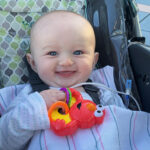‘Finally in the right place’: Peyton’s journey to Boston

When Peyton Miklas comes to Boston Children’s Hospital for an appointment, she isn’t just seeing Dr. Belinda Dickie, co-director of the Colorectal and Pelvic Malformation Center, or one of the other clinicians who care for her. The 18-month-old is also excited to visit with her buddy Bryson. The toddlers — who were born within a day of each other — and their moms have bonded over their shared diagnosis of a congenital difference.
Like Bryson, Peyton was born with a type of anorectal malformation called imperforate anus, in which the rectum doesn’t connect to the anus. “The doctor came over and told us that our daughter didn’t have an anus,” remembers her mother, Nicole. “My husband, Adam, and I just looked at each other like, ‘Wait, what? Is that even possible?’” The couple learned that, while the condition could be treated surgically, it would require multiple procedures, starting with a colostomy. All told, Peyton spent about two months in her local neonatal intensive care unit (NICU).

Making connections
Dissatisfied with their local physicians’ long-term care plan, Nicole and her husband researched other options. The search for a second opinion brought them to Dr. Dickie — and to online support groups. There, Nicole met Bryson’s mom, Carrie, and discovered their children’s similarities. “We connected really well, and Peyton and Bryson love each other,” says Nicole. “We started scheduling our appointments together so we can all meet up in Boston.”
It was during one of those appointments that Peyton’s parents learned that her health might be more complicated than they had anticipated. She had already been tested for VACTERL association, a syndrome that can include vertebral, anal, cardiac, tracheal, esophageal, renal and limb abnormalities. Peyton has the letters “VATER” of the syndrome.
“We knew when Peyton was born that she also had esophageal problems, but after her initial esophagus repair, we were told that was no longer an issue, and she was drinking breast milk and thriving, so we focused on the imperforate anus,” says Nicole. “We knew that our choice of surgeon to perform the procedure would be the biggest decision of our life — and could determine whether our daughter would be able to have or even control her bowel movements.”

Seamless care
Yet it wasn’t until their visit with Dr. Dickie that the family realized that Peyton’s “barky” cough could be something more serious. Concerned, the physician called in her colleague, Dr. Russell Jennings, to take a look. “It was during this initial meeting with Dr. Dickie and her team that we knew we had found our home away from home,” says Nicole. “Our daughter was finally in the right place after months of research, countless phone calls and emails and an empty feeling that we were getting nowhere. The uneasy concern of who could help our daughter was taken away almost immediately when we met with Dr. Dickie.”
A few weeks later, Dr. Jennings and the team at the Esophageal and Airway Treatment (EAT) Centerdetermined that not only did Peyton have a condition called tracheomalacia, but her airway was also severely narrowed due to strictures.
Suddenly, what had begun as a treatment plan for an imperforate anus was now more complicated — but despite the complexities, Nicole says that Peyton’s care was quite seamless. For example, while under anesthesia for the procedure with Dr. Dickie, she was able to have a triple scope done as well have as her urologist, Dr. Erin McNamara, examine her.
After a series of dilation procedures by the EAT team helped the little girl breathe easier, Dr. Dickie performed a type of pull-through procedure called a posterior sagittal anorectoplasty (PSARP) last February to repair the imperforate anus.

Giving others hope
Today, Peyton still travels regularly to Boston Children’s for care from her home in Long Island, New York. When the toddler, who loves books, music, and playing with her dog, Murphy, meets up with her friend Bryson, they have blast playing and popping soap bubbles together. Meanwhile, their moms have been busy working on their own project, creating welcome baskets for parents of babies in the NICU who have undergone colostomies.
Along with helpful resources, they include personal notes — and photos of their own children. “Not everyone is ready to reach out to this community just yet,” says Nicole. “But we want to show them that we were in their shoes just a year ago, and look where we are now. We want them to have hope, too.”
Related Posts :
-

‘Supported and heard’: Harven gets care for an anorectal malformation
Like lots of 3-year-olds, Harven Gifford has a great imagination. Lately, he’s taken to roaring loudly and pretending that ...
-

Jada’s story: After cloacal exstrophy repair, an unexpected gift
Koda Wilder Ladchuk was born slightly premature, healthy, and happy. But this isn’t just a story about 4-month-old Koda. ...
-

Finally heard: How finding a doctor who listened helped change Carter’s life
In some ways, Carter Sousa is like any other 13-year-old: He’s obsessed with videos, loves animals, and enjoys hanging ...
-

Treatment for anorectal malformation gives Steven freedom and confidence
Steven York has “come a very long way,” says his mother, Beth — both literally and figuratively. In just seven years, ...





